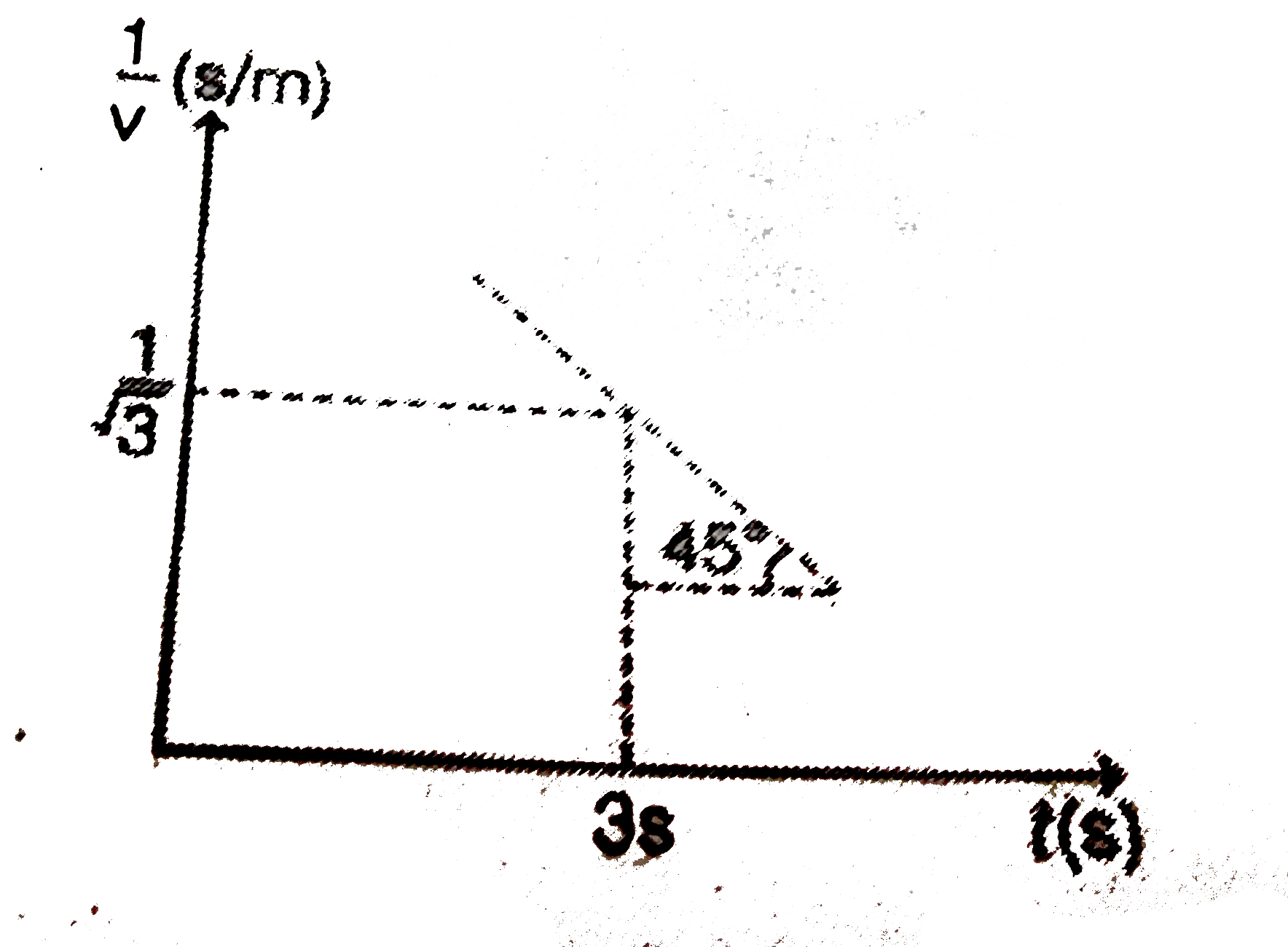The motion of a body is given by the equation dv/dt=6−3v, where v is in m//s. If the body was at rest at t=0
(i) the terminal speed is 2m/s
(ii) the magnitude of the initial acceleration is 6m/s2
(iii) The speed varies with time as v=2(1−e−3t)m/s
(iv) The speed is 1m/s, when the acceleration is half initial value
(i), (ii)
(ii), (iii),(iv)
(i), (ii), (iii)
All
The correct Answer is:D
To solve the problem step by step, we will analyze the given differential equation and verify each of the statements provided in the question.
Step 1: Understand the given differential equation
The motion of the body is described by the equation:
dvdt=6−3v
where v is the velocity of the body in meters per second.
Step 2: Find the terminal speed
The terminal speed occurs when acceleration becomes zero, i.e., when dvdt=0.
Setting the equation to zero:
0=6−3v
Solving for v:
3v=6⟹v=2m/s
Thus, the terminal speed is 2m/s.
Step 3: Calculate the initial acceleration
The initial acceleration can be found by substituting v=0 into the acceleration equation:
dvdt=6−3(0)=6m/s2
Thus, the magnitude of the initial acceleration is 6m/s2.
Step 4: Solve the differential equation
We can rearrange the equation for integration:
dv6−3v=dt
Integrating both sides:
∫16−3vdv=∫dt
The left side can be integrated using the substitution u=6−3v, leading to:
−13ln|6−3v|=t+C
Exponentiating both sides gives:
6−3v=Ce−3t
Solving for v:
3v=6−Ce−3t⟹v=2−C3e−3t
At t=0, the body is at rest (v=0):
0=2−C3⟹C=6
Thus, the velocity function is:
v=2−2e−3t
Rearranging gives:
v=2(1−e−3t)m/s
Step 5: Check when acceleration is half of the initial value
The initial acceleration is 6m/s2, so half of that is 3m/s2.
Setting the acceleration equation equal to 3:
6−3v=3
Solving for v:
3v=3⟹v=1m/s
Summary of Results
1. The terminal speed is 2m/s (True).
2. The magnitude of the initial acceleration is 6m/s2 (True).
3. The speed varies with time as v=2(1−e−3t)m/s (True).
4. The speed is 1m/s when the acceleration is half of the initial value (True).
Final Conclusion
All statements provided in the question are correct.
The motion of the body is described by the equation:
dvdt=6−3v
where v is the velocity of the body in meters per second.
The terminal speed occurs when acceleration becomes zero, i.e., when dvdt=0.
Setting the equation to zero:
0=6−3v
Solving for v:
3v=6⟹v=2m/s
Thus, the terminal speed is 2m/s.
The initial acceleration can be found by substituting v=0 into the acceleration equation:
dvdt=6−3(0)=6m/s2
Thus, the magnitude of the initial acceleration is 6m/s2.
We can rearrange the equation for integration:
dv6−3v=dt
Integrating both sides:
∫16−3vdv=∫dt
The left side can be integrated using the substitution u=6−3v, leading to:
−13ln|6−3v|=t+C
Exponentiating both sides gives:
6−3v=Ce−3t
Solving for v:
3v=6−Ce−3t⟹v=2−C3e−3t
At t=0, the body is at rest (v=0):
0=2−C3⟹C=6
Thus, the velocity function is:
v=2−2e−3t
Rearranging gives:
v=2(1−e−3t)m/s
The initial acceleration is 6m/s2, so half of that is 3m/s2.
Setting the acceleration equation equal to 3:
6−3v=3
Solving for v:
3v=3⟹v=1m/s
1. The terminal speed is 2m/s (True).
2. The magnitude of the initial acceleration is 6m/s2 (True).
3. The speed varies with time as v=2(1−e−3t)m/s (True).
4. The speed is 1m/s when the acceleration is half of the initial value (True).
All statements provided in the question are correct.
Topper's Solved these Questions
Similar Questions
The motion of a body is given by the equation dvdt=4−2v, where v is the speed in m/s and t in second. If the body was at rest at t = 0, then find
(i) The magnitude of initial acceleration
(ii) Speed of body as a function of time
View SolutionThe position of a particle is given by x=7+3t3 m and y=13+5t−9t2m, where x and y are the position coordinates, and t is the time in s. Find the speed (magnitude of the velocity) when the x component of the acceleration is 36m/s2.
View Solution
Knowledge Check
The motion of a body is given by the equation dνdt = 6−3ν where ν is the speed in ms−1 and t is time in s. The body is at rest at t = 0. The speed varies with time as
Aν=(1−e−3t)Bν=2(1−e−3t)Cν=1+e−2tDν=2(1+e−2t)The motion of a particle moving along x-axis is represented by the equation dvdt=6−3v, where v is in m/s and t is in second. If the particle is at rest at t = 0 , then
AThe speed of the particle in 2 /s when the acceleration of particle is zeroBAfter a long time the particle moves with a constant velocity of 2 m/sCThe speed is 0.1 m/s, when the acceleration is half of its initial valueDThe magnitude of final acceleration is 6m/s2A particle is moving in a circle of radius 1 m with speed varying with time as v=(2t)m/s. In first 2 s
Adistance travelled by the particle is 4mBdisplacement of the particle is 2 sin 2Caverage speed of the particle is 2 m/sDaverage velocity of the particle is zero
The diagram shows the variatioin of 1/v (where v is velocity of the particle) with respect to time. At time t=3s using the details given in the graph, find the instantaneous acceleration (in m/s2)

View SolutionA body moves so that it follows the following relation dvdt=−v2+2v−1 where v is speed in m/s and t is time in second. If at t=0, v=0 then find the speed (in m/s) when acceleration in one fourth of its initial value.
View SolutionIf in the previous problem, particle A moves with constant acceleration 4m/s2 with initial speed 5m/s and B moves with uniform speed 12m/s, when and where the particle meet?
View SolutionA particle is moving in a circle of radius 1 m with speed varying with time as v = (2t) m/s. In first 2 sec:
View SolutionThe velocity v of a body moving along a straight line varies with time t as v=2t2e−t, where v is in m/s and t is in second. The acceleration of body is zero at t =
View Solution
